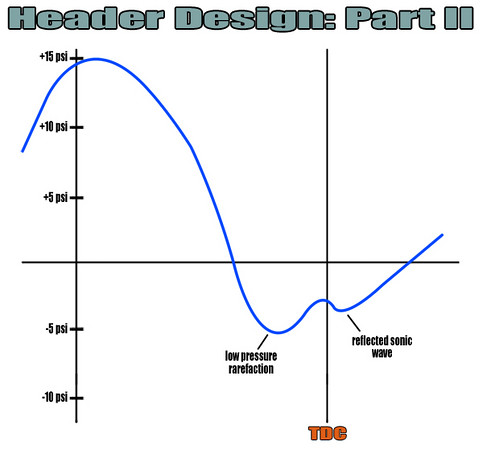,
Exceptions to the Rules!
The tuning rules we mentioned previously work most of the time for your typical old fashioned box collector header and Tri-Y header. However current state of the art header designs break these rules to produce amazing results with dimensions that are very different from conventional wisdom. State of the art headers have features such as merged collectors, collector venturis, megaphones and reverse cones.
 |
| A Burns collector is shown here while being fabricated into a header. You can see the merge, venturi and megaphone sections of the the collector |
A lot of the work on the new generation of headers is credited to the genius of Jack Burns. His beautiful merged collectors have revolutionized header design. Best of all, when you purchase a Burns collector, you can have your designed optimized by Jack himself through his X-Design software and phone consultation for free. A merged collector has a streamlined mitered merge instead of a simple box. The merged collector signifies the acoustic end of the tube but maintains a high velocity in this area for an even stronger rarefaction pulse. It’s smooth tapers also give a pulse over a wider RPM range over the abrupt primary termination of the traditional box collector.
 |
| This Honda K20A header by Hy-Tech features anti-reversion chambers, stepped primaries and a merged Tri-Y collector. You can see the nice merged construction of the collector in this picture |
A feature in the Burns collector is a venturi or a area of reduced diameter with a converging taper and a diverging exit. The venturi is found just after the merge. The venturi uses Bernoulli’s principal to increase the exhaust gas velocity creating a stronger scavenging pulse. For the tuning freak Burns has a collector with a tunable venturi so the collector can be optimized for the engine on a dyno.
 |
| Burns B-TEC collector has a tuneable venturi so the engines powerband can be fine tuned on a dyno or the track |
Other features found on a Burns designed headers are megaphones, which also help amplify and strengthen the scavenging pulse and reverse cones which create another point of wave reflection which usually helps improve after peak power, flattening the power curve instead of letting it fall abruptly.
 |
| This ASP header mounted on an SR20DE features primaries that step up from 1.75 to 1.875 at 13″ down a 26″ long primary tube |
Stepped primaries are where the primary tube steps up in diameter in equal segments along the length of the primary tube. The steps are usually in 1/8 inch increments. Usually a step is found 1/2 of the way down the primary but for engines with a real high rev range, a triple step is sometimes used, the primary may step from 1.75″ at the head to 1.875 and finally 2.00 inches by the collector in even intervals. Stepped primaries both serve as anti reversion devices and stay in tune longer.
Headers using some, any or all of these features usually have dimensions and power characteristics quite different from conventional wisdom. A Burns designed header will usually have a shorter primary tube of a larger diameter that has more low end power, a wider powerband and more top end than a composite of a Tri-Y and a conventional 4-1, especially on highly tuned engines with big cams.
 |
 |
| The Nismo header for the SE-R Spec-V Sentra and the Hotshot Gen 6 header for the SE-R powered by the SR20DE engine are examples of Tri-Y collector headers. The Gen 6 header also features stepped primaries |
The Tri-Y collector header design is another exception to conventional wisdom, this header has long primary tubes like a 4-1 but with a Tri-Y merge in the collector section. This sort of header typically has good peak power and a wide powerband. This is because having the interference branch merge in the collector makes for a longer higher volume interference branch and the longer primaries act like a 4-1.
 |
| This custom Honda B18C header by Hy-Tech has anti reversion chambers which are the bumps located about 6 inches down the primary tubes |
Another design exception is the Anti-Reversion header. Whether Anti-Reversion headers work or not is a controversial subject. Some engine builders say that highly tuned race engines with big overlap camshafts prefer anti-reversion headers. These have a chambered primary tube. In other words, the primary tube increases in diameter by about a quarter of an inch, a few inches from the head flange for about 2″. The chamber is believed to prevent reversion of the exhaust gases during the overlap period by trapping the reversion back pulse that can contaminate the cylinder with exhaust gas, creating a wider powerband and more torque.




5 comments
Good day… Is it safe to say that tuned\performance headers generate between 1-5PSI on an engine’s intake, once there is sufficient cam overlap? (what’s the correct figure) Thanks… =]
It does not generate any positive pressure on the intake, negative pressure in the header runner yes.
Not even with cam overlap?
No that’s more of a function of intake manifold design.
That’s not how headers work.